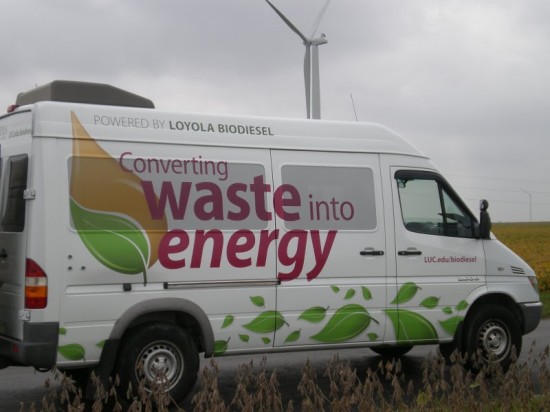
You smell it first…that familiar french-fry scent wafting by, was that a Sprinter? Yes, a biodiesel Sprinter, running on one of these three fuels:
- Commercially-available biodiesel – Almost always a blend of vegetable-oil-derived biodiesel blended with regular diesel fuel. “B30” is 30% biodiesel and 70% regular diesel fuel, all the way up to straight biodiesel (B100).
- SVO – Straight Vegetable Oil – Pure vegetable oil.
- WVO – Waste Vegetable Oil – Used vegetable oil, often produced from the filtered leftovers of restaurant deep-fryers.
Why run bio-diesel? Our petroleum use, for one – the US consumes 25% of the world’s oil, and we import over 70% of that from other countries. Biodiesel is a renewable fuel that can be produced in the US (typically from soybean-derived vegetable oil, lye, and natural-gas-derived methanol, though in the near future production from algae may produce yields of 1500-3000 gallons of oil/acre, vs. 50-70 gallons of oil per acre for soybeans).
The Biodiesel Resource site notes that biodiesel “provides up to a 90% reduction in most vehicle emissions, including those that cause cancer and contribute to global warming…Biodiesel production yields 96% less hazardous solid wastes, uses 79% less water, and consumes 70-90% less energy than fossil diesel production does. Blends as low as B20 have reduced soot exhaust by 83%.” The site also claims advantages to running even on a marginal biodiesel blend, especially for the fleet owner, such as:
- High lubricity (even B2 increases it more than 65%) extends engine life
- Higher cetane rating (46-62), which results in higher burn temperatures and cleaner burning
- Higher oxygen content (11%)
- Biodiesel acts as a solvent, cleaning any debris out of the fuel lines and tank. However, this may mean more frequent filter changes for dual-fuel vehicles.
That’s the theory, anyway. So what’s the reality of a Sprinter on biodiesel? Zach Waickman, manager of the Loyola University Biodiesel Lab, has seen the lab’s 2004 Sprinter run on B100 for years. He shoots down a couple of myths I’ve heard: “Fuel economy can suffer with the use of biodiesel. However, even using 100% biodiesel I have not seen more than a 5% decrease. Blends of biodiesel and diesel will have even less loss…”
How about extra maintenance? Sure, you may have to switch out fuel filters a few times at first if your Sprinter’s been running on diesel a long time before biodiesel use. But, says Zach, “I have not experienced any additional maintenance related to biodiesel use. I would recommend using a blend though: switching from 100% biodiesel to 100% diesel seems to stress the system and may cause false engine lights due to engine temperature fluctuation…biodiesel should be beneficial in the long run, as it lubricates and cleans out your engine.”
The cost of buying biodiesel commercially is higher than diesel right now (if you can even find it for sale in your town, since the Biodiesel Production Tax Credit lapsed in Jan 2010), unless you make your own or are part of a co-op. Another concern is voiding the MB warranty – the MB USA Sprinter Web site says: ” Mercedes-Benz Sprinters are approved to use B5 biodiesel (approved diesel fuel with a maximum 5% biodiesel content) in all BlueTEC engines. The only approved biodiesel content is one that both meets ASTM D6751 specifications and has the oxidation stability necessary to prevent deposit-/corrosion-related damages to the system (min. 6h, proven by EN14112 method)…. The Mercedes-Benz Sprinter New Vehicle Limited Warranty does not cover damage caused by non-Mercedes-Benz approved fuel standards.”
However, even with these possible concerns, there are plenty of Sprinters in the US using not just regular biodiesel fuel (which requires no changes at all to your vehicle), but also SVO and WVO (vegetable oil) fuel options. Ray McCormack doesn’t think twice about the value of his veggie-oil-fueled Sprinter – Ray went to the trouble of installing a WVO conversion kit from Frybrid on his 2005 Sprinter 2500 (in Dec 2009, as his blog notes). The Frybrid WVO kit may be one of the most complete auto vegetable oil conversion kits on the US market, at least by the looks of their kit comparison.
Ray says the cost was fairly low, and the results good: “My out of pocket expense for the auto installation was about $2k ($1600/kit; $200 for tank; $200 for new injection hose and clamps as well as some electrical and control panel). (I) had to fabricate brackets for items under the hood, and pretty much made my own tank…at a cost of about $200 with inspection port and other fittings/hardware…I am typically getting around 25 mpg on diesel & 22 mpg on WVO with nothing in the van. Whether I am on diesel or WVO hauling my Avon (boat) full of wood and camping gear from an elevation of 200 ft to 8000 ft, I am getting about 15 mpg.”
For the moment, Ray’s WVO Sprinter may be pioneering a path most of us Sprinter drivers have yet to follow. But using even B5 biodiesel doesn’t require any modifications, produces less pollution, and may give your Sprinter a longer engine life – what more do you want, fries with that?
More
- Where’s the nearest biodiesel station? Nearbio tells you about over 1500 US stations, on their Web site or via SMS to your cell phone.
- Josh Tickell’s Sundance award-winning documentary Fuel is a brilliant and inspiring film about biofuels and their possibilities as better fuel sources.
For more examples of biodiesel Sprinters, see:
- EcoShuttle.net: Portland-based shuttle company runs a Sprinter shuttle van on B100.
- Sustainable Vine: Santa Barbara wine tour runs a Sprinter tour van on B100.
- More biodiesel Sprinters run by Peace Coffee, Essential Baking, CLIF Bar, Guayaki Yerba Mate, the list goes on…




Comments on this entry are closed.